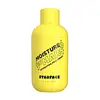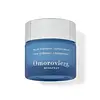What's inside
What's inside
 Key Ingredients
Key Ingredients

 Benefits
Benefits

 Concerns
Concerns

 Ingredients Side-by-side
Ingredients Side-by-side

Water
Skin ConditioningIsononyl Isononanoate
EmollientCaprylic/Capric Triglyceride
MaskingCetearyl Olivate
C14-22 Alcohols
Emulsion StabilisingSorbitan Olivate
EmulsifyingEthylhexylglycerin
Skin ConditioningC12-20 Alkyl Glucoside
EmulsifyingSilica
AbrasiveXanthan Gum
EmulsifyingGlycerin
HumectantTocopheryl Acetate
AntioxidantButylene Glycol
HumectantAloe Barbadensis Leaf Extract
EmollientTocopherol
AntioxidantSodium Hyaluronate
HumectantMagnesium Aspartate
Skin ConditioningZinc Gluconate
Skin ConditioningPhenoxyethanol
PreservativeOcimum Sanctum Leaf Extract
Skin ConditioningSalvia Officinalis Leaf Extract
CleansingCopper Gluconate
Skin ConditioningSodium Benzoate
MaskingPotassium Sorbate
PreservativePanax Ginseng Root Extract
EmollientChenopodium Quinoa Seed Extract
Skin ConditioningDaucus Carota Sativa Root Extract
Skin ConditioningGlycine Max Seed Extract
Skin ConditioningOryza Sativa Extract
AbsorbentWater, Isononyl Isononanoate, Caprylic/Capric Triglyceride, Cetearyl Olivate, C14-22 Alcohols, Sorbitan Olivate, Ethylhexylglycerin, C12-20 Alkyl Glucoside, Silica, Xanthan Gum, Glycerin, Tocopheryl Acetate, Butylene Glycol, Aloe Barbadensis Leaf Extract, Tocopherol, Sodium Hyaluronate, Magnesium Aspartate, Zinc Gluconate, Phenoxyethanol, Ocimum Sanctum Leaf Extract, Salvia Officinalis Leaf Extract, Copper Gluconate, Sodium Benzoate, Potassium Sorbate, Panax Ginseng Root Extract, Chenopodium Quinoa Seed Extract, Daucus Carota Sativa Root Extract, Glycine Max Seed Extract, Oryza Sativa Extract
Water
Skin ConditioningButyrospermum Parkii Butter
Skin ConditioningCetearyl Ethylhexanoate
EmollientOctyldodecanol
EmollientSqualane
EmollientGlycerin
HumectantCaprylic/Capric Triglyceride
MaskingStearyl Heptanoate
EmollientCetearyl Olivate
Cetearyl Alcohol
EmollientSorbitan Olivate
EmulsifyingSaccharomyces/Grape Ferment Extract
Skin ConditioningCera Alba
EmollientPhenoxyethanol
PreservativeSucrose Palmitate
EmollientDipalmitoyl Hydroxyproline
Skin ConditioningAscorbyl Tetraisopalmitate
AntioxidantPullulan
Benzyl Alcohol
PerfumingSodium Hyaluronate
HumectantGlyceryl Linoleate
EmollientTocopheryl Acetate
AntioxidantPrunus Domestica Seed Extract
EmollientXanthan Gum
EmulsifyingEthylhexylglycerin
Skin ConditioningCopper Gluconate
Skin ConditioningMethylglucoside Phosphate
Skin ConditioningCopper Lysinate/Prolinate
Skin ConditioningTocopherol
AntioxidantParfum
MaskingDisodium EDTA
Tropaeolum Majus Flower/Leaf/Stem Extract
Skin ConditioningPhospholipids
Skin ConditioningDehydroacetic Acid
PreservativeSodium Hydroxide
BufferingPotassium Sorbate
PreservativeAcetyl Sh-Pentapeptide-1
Skin ConditioningColloidal Diamond
Skin ProtectingSilica
AbrasiveLinalool
PerfumingLimonene
PerfumingGeraniol
PerfumingCitral
PerfumingWater, Butyrospermum Parkii Butter, Cetearyl Ethylhexanoate, Octyldodecanol, Squalane, Glycerin, Caprylic/Capric Triglyceride, Stearyl Heptanoate, Cetearyl Olivate, Cetearyl Alcohol, Sorbitan Olivate, Saccharomyces/Grape Ferment Extract, Cera Alba, Phenoxyethanol, Sucrose Palmitate, Dipalmitoyl Hydroxyproline, Ascorbyl Tetraisopalmitate, Pullulan, Benzyl Alcohol, Sodium Hyaluronate, Glyceryl Linoleate, Tocopheryl Acetate, Prunus Domestica Seed Extract, Xanthan Gum, Ethylhexylglycerin, Copper Gluconate, Methylglucoside Phosphate, Copper Lysinate/Prolinate, Tocopherol, Parfum, Disodium EDTA, Tropaeolum Majus Flower/Leaf/Stem Extract, Phospholipids, Dehydroacetic Acid, Sodium Hydroxide, Potassium Sorbate, Acetyl Sh-Pentapeptide-1, Colloidal Diamond, Silica, Linalool, Limonene, Geraniol, Citral
Ingredients Explained
These ingredients are found in both products.
Ingredients higher up in an ingredient list are typically present in a larger amount.
This ingredient is an emollient, solvent, and texture enhancer. It is considered a skin-softener by helping the skin prevent moisture loss.
It helps thicken a product's formula and makes it easier to spread by dissolving clumping compounds.
Caprylic Triglyceride is made by combining glycerin with coconut oil, forming a clear liquid.
While there is an assumption Caprylic Triglyceride can clog pores due to it being derived from coconut oil, there is no research supporting this.
Learn more about Caprylic/Capric TriglycerideCetearyl Olivate is an emulsifier and texture enhancer. It is derived from the fatty acids of olive oil and Cetearyl alcohol, and is biodegradable.
As an emulsifier, it is used to prevent oils and waters from separating. It can also
Manufacturers use the name Olivem 1000. This ingredient has been found to preserve the natural microbiome of skin. Having a healthy microbiome helps keep our skin healthy and protects against harmful bacteria. This ingredient is grouped with Sorbitan Olivate under the name Olivem 1000.
Learn more about Cetearyl OlivateThis ingredient is a copper salt known for its wound healing properties.
Our bodies use copper to help stabilize our skin's collagen and elastin. Its also an essential for superoxide dismutase, an enzyme with strong antioxidant properties.
Copper has wound healing properties due to its role in creating new blood vessels and tissue repair.
Learn more about Copper GluconateEthylhexylglycerin (we can't pronounce this either) is commonly used as a preservative and skin softener. It is derived from glyceryl.
You might see Ethylhexylglycerin often paired with other preservatives such as phenoxyethanol. Ethylhexylglycerin has been found to increase the effectiveness of these other preservatives.
Glycerin is already naturally found in your skin. It helps moisturize and protect your skin.
A study from 2016 found glycerin to be more effective as a humectant than AHAs and hyaluronic acid.
As a humectant, it helps the skin stay hydrated by pulling moisture to your skin. The low molecular weight of glycerin allows it to pull moisture into the deeper layers of your skin.
Hydrated skin improves your skin barrier; Your skin barrier helps protect against irritants and bacteria.
Glycerin has also been found to have antimicrobial and antiviral properties. Due to these properties, glycerin is often used in wound and burn treatments.
In cosmetics, glycerin is usually derived from plants such as soybean or palm. However, it can also be sourced from animals, such as tallow or animal fat.
This ingredient is organic, colorless, odorless, and non-toxic.
Glycerin is the name for this ingredient in American English. British English uses Glycerol/Glycerine.
Learn more about GlycerinPhenoxyethanol is a preservative that has germicide, antimicrobial, and aromatic properties. Studies show that phenoxyethanol can prevent microbial growth. By itself, it has a scent that is similar to that of a rose.
It's often used in formulations along with Caprylyl Glycol to preserve the shelf life of products.
Potassium Sorbate is a preservative used to prevent yeast and mold in products. It is commonly found in both cosmetic and food products.
This ingredient comes from potassium salt derived from sorbic acid. Sorbic acid is a natural antibiotic and effective against fungus.
Both potassium sorbate and sorbic acid can be found in baked goods, cheeses, dried meats, dried fruit, ice cream, pickles, wine, yogurt, and more.
You'll often find this ingredient used with other preservatives.
Learn more about Potassium SorbateSilica, also known as silicon dioxide, is a naturally occurring mineral. It is used as a fine, spherical, and porous powder in cosmetics.
Though it has exfoliant properties, the function of silica varies depending on the product.
The unique structure of silica enhances the spreadability and adds smoothness, making it a great texture enhancer.
It is also used as an active carrier, emulsifier, and mattifier due to its ability to absorb excess oil.
In some products, tiny microneedles called spicules are made from silica or hydrolyzed sponge. When you rub them in, they lightly polish away dead skin layers and enhance the penetration of active ingredients.
Learn more about SilicaSodium Hyaluronate is hyaluronic acid's salt form. It is commonly derived from the sodium salt of hyaluronic acid.
Like hyaluronic acid, it is great at holding water and acts as a humectant. This makes it a great skin hydrating ingredient.
Sodium Hyaluronate is naturally occurring in our bodies and is mostly found in eye fluid and joints.
These are some other common types of Hyaluronic Acid:
Learn more about Sodium HyaluronateSorbitan Olivate is created from the fatty acids in olive oil and sorbitol.
This ingredient is an oil in water emulsifier. It helps stabilize a product by preventing oils and waters from separating. Sorbitan Olivate also helps hydrate the skin.
Manufacturers sell sorbitan olivate under the name OliveM 1000. OliveM 1000 a multifunctional ingredient. It is self-emulsifying. According to a manufacturer, OliveM 1000 does not disrupt natural skin biome.
Due to its olive oil base, this ingredient may not be fungal-acne safe.
Learn more about Sorbitan OlivateTocopherol (also known as Vitamin E) is a common antioxidant used to help protect the skin from free-radicals and strengthen the skin barrier. It's also fat soluble - this means our skin is great at absorbing it.
Vitamin E also helps keep your natural skin lipids healthy. Your lipid skin barrier naturally consists of lipids, ceramides, and fatty acids. Vitamin E offers extra protection for your skin’s lipid barrier, keeping your skin healthy and nourished.
Another benefit is a bit of UV protection. Vitamin E helps reduce the damage caused by UVB rays. (It should not replace your sunscreen). Combining it with Vitamin C can decrease sunburned cells and hyperpigmentation after UV exposure.
You might have noticed Vitamin E + C often paired together. This is because it is great at stabilizing Vitamin C. Using the two together helps increase the effectiveness of both ingredients.
There are often claims that Vitamin E can reduce/prevent scarring, but these claims haven't been confirmed by scientific research.
Learn more about TocopherolTocopheryl Acetate is AKA Vitamin E. It is an antioxidant and protects your skin from free radicals. Free radicals damage the skin by breaking down collagen.
One study found using Tocopheryl Acetate with Vitamin C decreased the number of sunburned cells.
Tocopheryl Acetate is commonly found in both skincare and dietary supplements.
Learn more about Tocopheryl AcetateWater. It's the most common cosmetic ingredient of all. You'll usually see it at the top of ingredient lists, meaning that it makes up the largest part of the product.
So why is it so popular? Water most often acts as a solvent - this means that it helps dissolve other ingredients into the formulation.
You'll also recognize water as that liquid we all need to stay alive. If you see this, drink a glass of water. Stay hydrated!
Learn more about WaterXanthan gum is used as a stabilizer and thickener within cosmetic products. It helps give products a sticky, thick feeling - preventing them from being too runny.
On the technical side of things, xanthan gum is a polysaccharide - a combination consisting of multiple sugar molecules bonded together.
Xanthan gum is a pretty common and great ingredient. It is a natural, non-toxic, non-irritating ingredient that is also commonly used in food products.
Learn more about Xanthan Gum